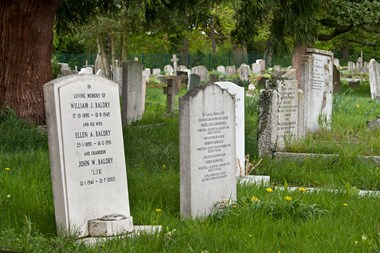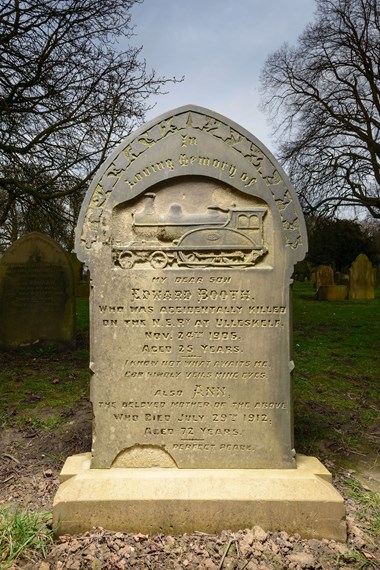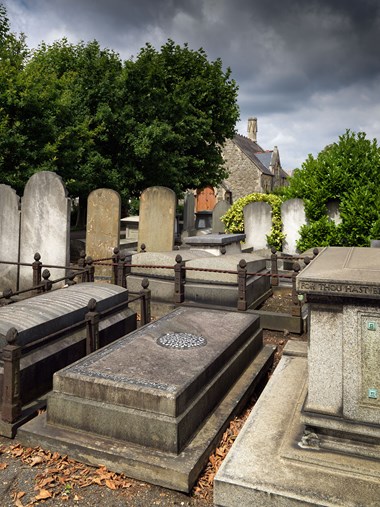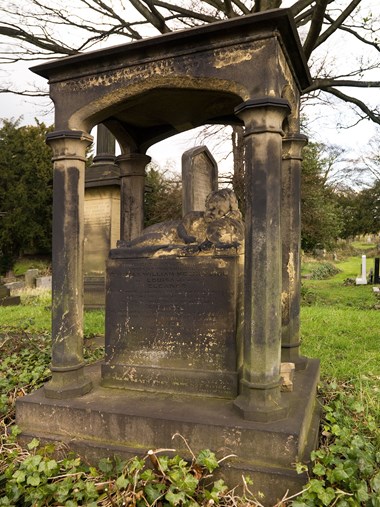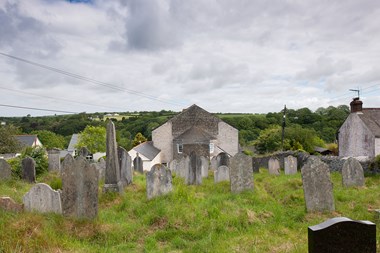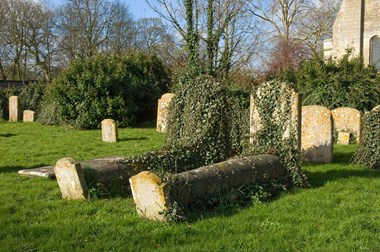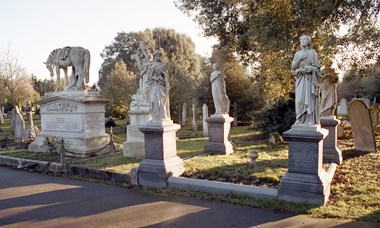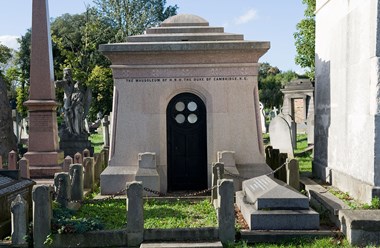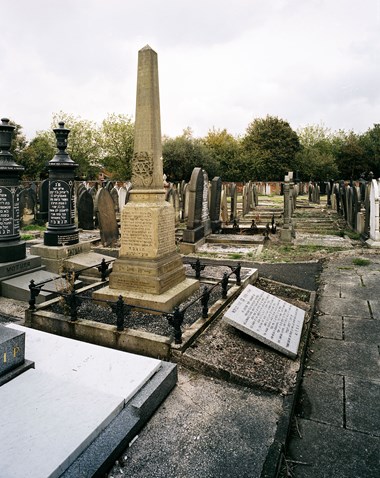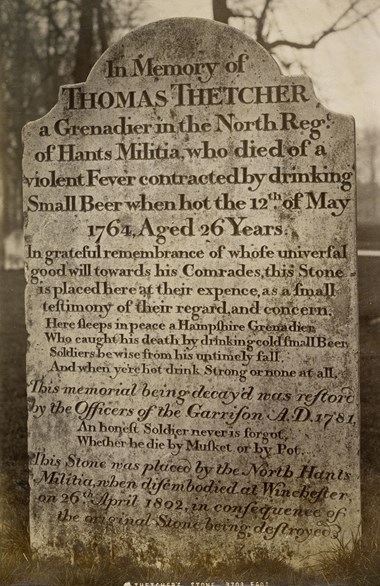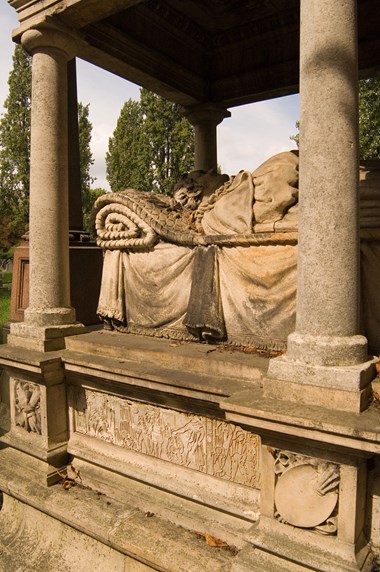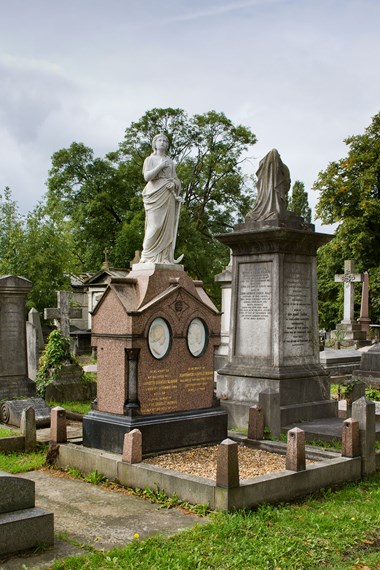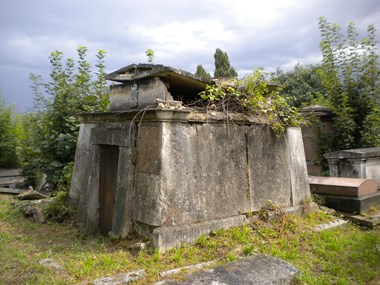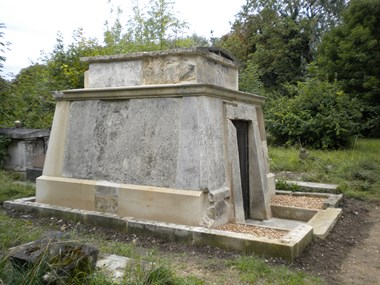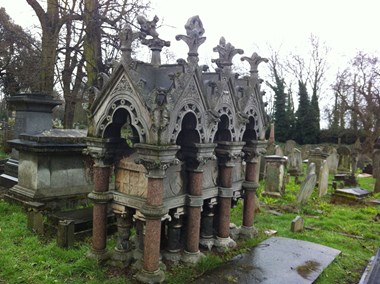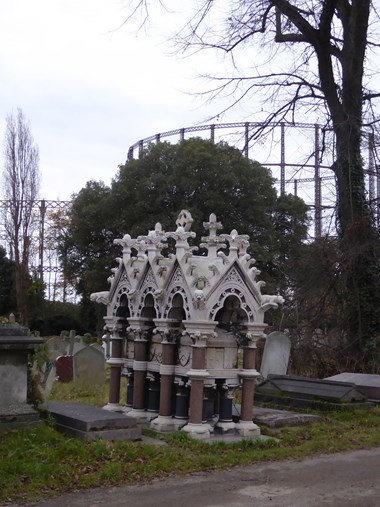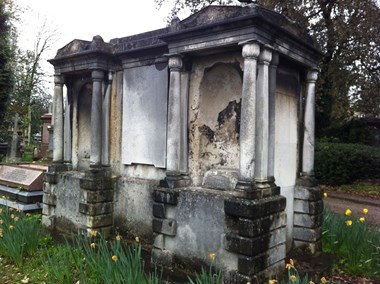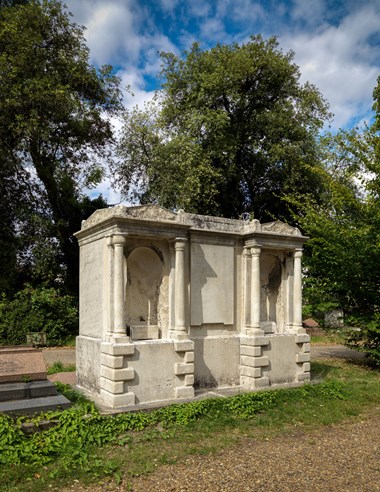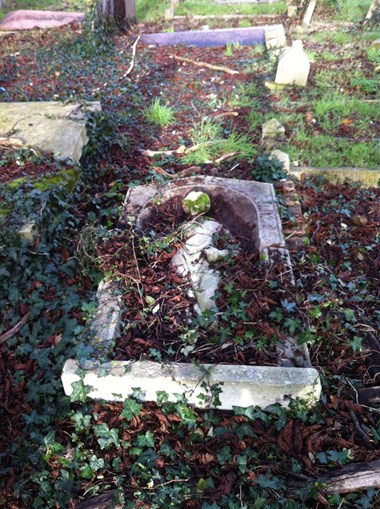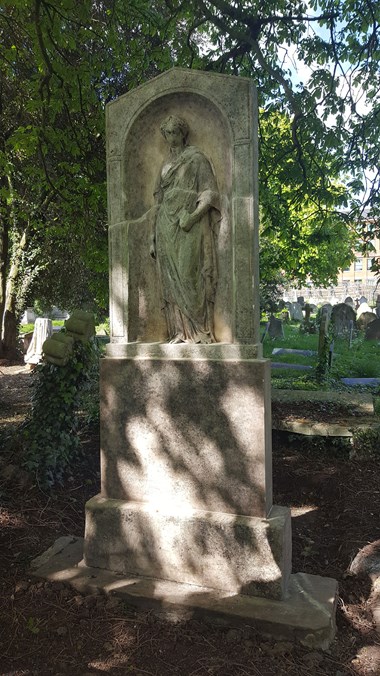Caring for Historic Cemetery and Graveyard Monuments
One of the most important and interesting features in a cemetery or graveyard are the monuments. Often spanning many generations they reflect beliefs and ideas about commemoration, styles and tastes over time. They range from the simplest small gravestone to small buildings.
Types of monuments
The main types of monuments are:
- Marker stones at the ‘head’ and/or the ‘foot’ of the grave. They are rarely decorated and may only give the name and dates of the person.
- Headstones often have inscriptions and decorative low-relief motifs such as a cross and lilies representing death and mourning. Sometimes kerbstones (delineating the boundary of the grave) survive but often these have been lost or removed to make grass cutting easier.
- Ledger slabs are large stones laid flat over the grave. Sometimes you see curved body stones that look like a grave mound.
- Tomb chests are usually rectangular and hollow. The side panels are fixed at the corners with metal (usually iron) cramps or the panels are fixed to brick core walls.
- Table tombs are similar to tomb chests but these are square or round and the big slab is supported on legs or columns.
- Mausolea are the grandest monuments. These small buildings dedicated to an individual or family to house the dead can be elaborately decorated inside if you can get access.
- Sculpture of symbolic representations of death and mourning such as crosses, obelisks and broken columns, and figures such as angels and weeping women.
- Graveboards are wooden panels. Very few survive.
Image gallery
Please click on the gallery images to enlarge.
Materials used for monuments
Usually gravestones and monuments in historic churchyards reflect locally available building materials, especially stones. In cemeteries a more diverse and flamboyant range of materials were used.
When planning conservation work it is important to identify all materials and their condition.
Examples of materials you will find include:
- Stones: limestones. sandstones, granites, marbles and slates
- Metals: iron, bronze, lead
- Other materials such as terracotta, artificial stones
- Wood
Image gallery
Please click on the gallery images to enlarge.
Deterioration
All materials weather and deteriorate especially when exposed to the atmosphere. The rate will vary according to the:
- Types of materials and their properties
- Methods of construction
- Design and structure, and detailing
- Degree of exposure
- Environmental conditions
- Inappropriate work or lack of care
For any monument, assessment of the deterioration and its causes is essential to planning and carrying out any work.
Stone
Although stone is a tough material, it is porous. Repeated wetting and drying of the stone often causes movement and crystallisation of salts, disrupting the stone matrix and swelling of component minerals, such as clays, which can lead to weakening of the stone structure. Stones can also be attacked by pollution such as sulphur dioxide, nitrogen oxides and ozone, which can lead to surface soiling and chemical change. Marbles are particularly sensitive to pollutants. They lose their polish. On old marbles and limestones you also see ‘sugaring’ with loose grains and black crusts. On sandstones a brittle crust forms which exfoliates.
Sometimes stone monuments fail because the design and construction fails to use the stones’ strongest and natural bedding planes. This increases the rate of deterioration.
Deterioration to the point of structural failure takes a long time, but even minor surface loss affects details, such as inscriptions.
Metals
Iron
Historic iron is either cast or wrought. Cast iron, as its name suggests is cast and contains a small amount of carbon. Wrought iron is a relatively pure form or iron and is formed though forging. Well maintained iron is robust but if it is not looked after it will rust and gradually disintegrate. Wrought iron tends to delaminate along the lines of its forged structure. Cast iron is more brittle and tends to fracture.
Corrosion of metal cramp fixings can fracture the stone or push slabs apart. Our case study Waterloo Memorial at Wigan looks at the damage caused by corroded wrought-iron cramps used to secure the stones of an obelisk and repair options.
Bronze
An alloy based on copper and tin, together with lead or other materials.
Bronze is extremely resilient and corrosion is usually superficial. As part of its manufacture, it will often have been given a surface finish or coating to create a patina. However, over time non-ferrous metals will develop a natural patina, which comprises relatively stable corrosion products. Active corrosion products, typically in the form of green powdery pustules in unwashed areas, are likely to cause the bronze to deteriorate.
Unless protected with a suitable surface treatment (often wax based), the run-off from bronzes can cause deep-seated green staining to porous stones underneath.
Our three case studies on bronze elements look at:
- Assessing condition, cleaning and re-patination work
- Lack of maintenance of protective wax coatings
- Replacing missing elements
Brass
Brass is an alloy, primarily of copper and zinc, though often with other elements, such as tin added. Although not commonly used on cemetery and graveyard monuments, but is sometimes used for inscription plaques.
The most common causes of deterioration to brass are corrosion (usually caused by condensation or other sources of moisture) and over-zealous cleaning. Brass is associated with a highly polished surface but it is liable to tarnishing from being touched – grease, moisture and salts are all present on fingers. The temptation is for this patchy finish to be removed by further polishing. However, this is an abrasive process and is not sustainable in the long term.
Lead
Lead is a soft, malleable metal which is blueish-white when freshly cut, but turns to a dull grey over time. It is used for statuary and lettering. Lead statuary is prone to splitting as a result of corrosion of iron armatures. It can also deform, slumping under its own weight. Lead lettering can easily become detached, particularly if the surface of the stone in which it is set has eroded back. Birds will sometimes peck at the lead and loosen it.
Brick and terracotta
Fired materials, like brick and terracotta will decay if their more resilient outer surface is damaged.
Wood
Wood is susceptible to light, wind and moisture. The combination of all these can cause a change in appearance, surface cracks and erosion.
Wet wood will readily become a habitat for fungi and rot sets in breaking down the wood structure. Insect larvae feed on the rotting wood and destroy it.
Paint and surface finishes
Inscriptions are frequently painted or gilded, and sometimes this decoration can extend to the other elements of a monument. Historic paints are likely to contain toxic white lead compounds.
It is likely that original paint or surface finish will have been worn away or over-painted, but some may remain and should be analysed to establish the type(s) and colour(s) present, which will allow informed decisions on any treatment, re-painting or re-gilding.
Plant growth
Plant growth can exacerbate monument deterioration. Although moulds, algae and lichens can create a patina that enhances the aged appearance of monuments, excessive colonisation can obscure inscriptions. Some growths secrete acidic deposits which in the long term may lead to deterioration of stone surfaces.
Creeping plants like ivy can engulf monuments so they become lost and the overgrowth masking hazards hidden underneath. Trees and woody shrubs are common causes of damage to monuments. They can push apart or rub against gravestones and monuments, and trees and branches falling on monuments can cause immense damage.
However plants and trees are part of the wildlife and landscape design interest of a cemetery or graveyard. The web section The Importance of Historic Cemeteries and Burial Grounds provides more information. Some plants, birds and animals are protected by law.
Structural problems
Ground subsidence can cause a monument to lean, subside or collapse. The subsidence may be due to:
- Lack of or insubstantial foundations
- Disturbance from tree roots or burrowing animals
- Collapse of coffins and vaults
Movement can put stress on the monument and can fracture stones or open up joints. Fractures and open joints within a structure will inevitably lead to compounding problems: moisture movement, accumulation of debris and establishment of woody plants, such as shrubs and trees. Our technical guidance on diagnosing and understanding the structural problems and case study on differential movement in foundations offer more advice.
Inappropriate repairs, cleaning and coatings
Even well-intentioned maintenance or repairs to monuments can cause irreversible damage. Common examples are:
- Cement pointing and repairs: Stone and brick are generally relatively porous materials. Repairs or re-pointing with hard, impervious mortars like cement based mortars will lead to the stone or brick being damaged. Our guidance on repointing provides more advice.
- Inappropriate cleaning, for example pressure washing
- Inappropriate surface coatings
Over time the use of impervious protective coatings or sealers can trap water, resulting in surface damage to the monument.
Planning and carrying out work
Condition surveys
Sometimes monuments need work in order to ensure they survive. A condition survey is an essential first step and ideally these should be part of a cemetery or graveyard conservation management plan.
A condition survey helps plan what works are needed and priorities. For each monument the survey should record:
- Location (including section and grave number if appropriate)
- Dimensions
- Monument type and description
- Orientation of the monument and inscribed faces
- Inscription technique such a lead filled, incised, painted
- Names, dates of death, dedication
- Designer/sculptor, mason
- Construction materials
- Significance, including List entry or Local List entry (if applicable)
- Structural condition including previous repairs, whether the monument is tilting or falling apart, open joints or cracks, ground conditions like visible subsidence, problems with the foundations, plant growth issues
- Surface condition noting soiling, plant growth issues, type and extent of deterioration, whether the inscription can be read
- Evidence of previous work
- Emergency stabilisation needed?
- Who carried out the inspection
- Date of inspection
The condition survey will also help inform the cemetery’s health and safety risk assessment (see next section).
Our one-page guide about carrying out a survey and monument survey form provide a step-by-step briefing.
ChurchCare published guidelines about minimum requirements for conservation reports for faculty ad grant applications for churches and other church property.
Risk assessments
Historic memorials and monuments may not be perfectly upright or appear unstable but this doesn’t necessarily mean they are unsafe or at risk.
However, your safety and the safety of others are paramount. Any concerns should be reported to the cemetery or graveyard manager so they can take immediate action to cordon off the monument and seek specialist advice. Ideally any safety measures such as dismantling unstable monuments or fencing should be followed by plans to repair and reinstate them.
Accidents, and very sadly a few fatalities in the 1990s, highlighted the need for these risk assessments. Since these initial assessments, the systems have been reviewed and revised, but some of the earlier risk management strategies led to many memorials deemed unsafe being dismantled and laid down. Once dismantled, the monuments and any component parts are vulnerable to damage.
Some testing techniques also undermined or damaged headstones and monuments, adding to the problems. In many cemeteries large areas were cordoned off with unsightly tape and fencing where memorials were deemed unsafe.
With few or no plans to resolve the problems, the character of many historic cemeteries has unintentionally been undermined and it is challenging whether these areas will ever be restored.
Local authorities now carry out regular inspections of their cemeteries. Usually these surveys are carried out every five years. It is now generally accepted that laying down memorials is inappropriate and councils will look at alternatives but laying down may be necessary if a memorial is unsafe.
Whilst the cemetery or graveyard owner has a health and safety duty for the site, the individual monuments are privately owned and the descendants of the original grave owner (if they can be traced) are technically responsible for maintaining their memorial in a safe condition. Often monument owners cannot be traced (see next section), but where repairs are needed in the interests of preserving the monument and the amenity of a cemetery, the cemetery owner and conservation groups may step in to help with the costs. Through our Heritage at Risk programme, Historic England is tackling important listed cemetery and graveyard monuments.
The Institute of Cemetery and Crematoria website has a section on health and safety and also runs training courses.
The National Federation of Cemetery Friends also provides advice about safety issues to consider for activities such as work parties and guided walks.
Image gallery: Repair of listed monuments at Kensal Green Cemetery as part of Historic England's Heritage at Risk Programme
Please click on the gallery images to enlarge.
Consulting owners of memorials about repairs
The permission of the owner of the monument and their help with the costs needs to be sought before any works are undertaken. Monuments are privately owned. For many monuments, it will prove very difficult to find the current owner(s), but you must be able to demonstrate you took all reasonable steps to do so.
The starting point is the cemetery’s or graveyard’s own burial records and then using family history resources like census records and online family trees to look for descendants. Volunteers, especially family historians, can often help undertake research. Notices should be served on the owners via recorded delivery post and any returned ‘unknown’ letters filed.
Notices will need to be posted on site explaining the cemetery is trying to get in contact with the owner(s) and that works are planned. These can be posted by the grave, on cemetery notice boards, and the cemetery entrance, local newspapers, social media, and web sites. It is likely notices will need to be kept in place for at least 12 months to give grave visitors, who may visit only once a year, a chance to pick up the information and get in contact.
A record should be kept of all notices in case there are future queries.
If the monument is listed you may need to apply for listed building consent or an ecclesiastical faculty.
Carrying out work
Some work can be carried out by volunteers, but more specialist activities will need qualified conservators or memorial masons. Read more about commissioning works in section 13 (pages 70-72) in our guidance.
Advice on finding suitable contractors is available from:
- Institute of Conservation
- British Register of Accredited Memorial Masons (BRAMM)
- National Association of Memorial Masons (NAMM)
Recording work
Any work carried out should be recorded and made available to others. This is so that the condition and any changes can be monitored in the future.
Good quality photographs are a quick and easy way of capturing this information. They should be taken before, during and after the work and should document key stages.
Written documentation outlining the work, methods and materials used, as well as who and when the work was undertaken.
All records should be stored with the cemetery or graveyard authorities and copies should be sent to the local Historic Environment Records.
Clearing vegetation
It may be necessary to clear vegetation growing over and around the monument in order to assess its condition and what work is needed. Vegetation may obscure hazards such as loose sculpture, unstable structures and deep holes. Clearance needs to be carried out very carefully to make sure no one is hurt and the monument is not accidentally damaged.
Any proposed clearance work should not be carried out in the bird nesting season (March to August). Contractors will be needed if you have to clear large branches and trees, and vegetation growing high up on monuments. Thought needs to be given to how the areas will be managed once they have been cleared of overgrown vegetation. Volunteers can help stop young tree and shrub seedlings growing into future problems by regularly weeding these small plants from monuments.
Our step-by-step guide provides advice.
Resetting fallen monuments
Simple, tall gravestones are typically made of long panels of stone set directly in the ground. Even if the headstone is tilting it doesn’t mean it is unstable, but its stability should be assessed.
If gravestones have been laid flat, the first step is to work out their correct original location and orientation. If they have been swamped by overgrown vegetation, they will need to be carefully freed and allowed to dry before their condition can be assessed.
Resetting involves heavy manual working and appropriate host equipment will be needed. Volunteers should not attempt this work. The following advice is offered to give you an idea of the work that might be involved.
When a headstone is reset in the ground it should have a minimum of a third of its length buried. If the inscription is close or below the ground resetting on a base should be considered. The hole should be backfilled and compacted to provide support.
Since the early 19th century, many gravestones have been set on bases with either a setting slot or pins to hold the stone. If these types of gravestones are loose, the base will need re-fixing. All re-fixing and repairs should be carried out using sympathetic materials. For more information about these, please see our text book Practical Building Conservation: Stone
Dismantling and rebuilding larger monuments
This is highly skilled work and requires specialist consultants and contractors. A thorough structural investigation will be needed before any works are carried out to identify the causes of deterioration and the approach to the monument’s repair. This investigation will also consider foundations and the underground grave space. There is best practice guidance published on the treatment of human remains. Generally monuments should not be dismantled unless absolutely necessary. Before a monument is dismantled, it will need to be carefully recorded so that the structure can be accurately rebuilt.
New foundations and core, a damp proof membrane, and additional fixings may be needed. Rebuilding will normally involve removing decayed or defective fixings and repairs, and replacing cramps and fixings with new stainless-steel versions. All re-fixing and repairs should be carried out using sympathetic materials. For more information about these, please see our book Practical Building Conservation: Stone. This work needs to be carried out by a stone conservator.
Repairs
This is highly skilled work and requires specialist contractors. All re-fixing and repairs should be carried out by suitably experienced practitioners, using sympathetic materials.
Fractures can be repaired and broken parts re-joined. Missing pieces may be buried in vegetation around the monument. The stone conservator will carefully clean the surfaces and work out their fit, then stick pieces together with appropriate adhesives.
Joints may have failed due to erosion, cracking, separation or complete disintegration and should be repointed. The old mortar needs to be carefully removed by hand (abrasive disc cutters are rarely appropriate), and replaced with a suitably new mortar which is physically and aesthetically compatible with the stone. For more information about mortars, please refer to our book Practical Building Conservation: Mortars, Renders and Plasters. Further advice is given in our repointing guidance.
Cleaning
Cleaning is a major intervention for a historic monument. Generally cleaning should only be carried out to allow further conservation work or if the soiling is causing damage to the monument fabric. The aim is not to make the monument look new but to carefully remove harmful deposits or staining. The mildest and least damaging methods should be deployed.
Our guidance on cleaning provides more detailed advice.
There are also four videos:
Tackling vandalism and removing graffiti
Unfortunately monuments are occasionally subject to theft or vandalism.
The presence of valuable metals has meant that theft has recently been more prevalent.
The best way of deterring starts with assessing the risks:
- Identify the value of the materials form which the monument is constructed
- Recognise the added art-market value of any of the monument’s components, especially those attributed to a famous artist
- Understand how easily valuable elements could be removed
- Consider ease of access both by foot and vehicle
- Work out what security is already in place e.g. CCTV, lighting, signs
Once the risk assessment has been completed, a plan of action should he drawn up to mitigate those risks. This might include increasing visibility of the monument, installing additional fixings and encouraging local vigilance. Our Prevention Measures guidance provides practical advice on deterring heritage crime.
If theft does take place, replacement should in general be on a like-for-like basis, but with additional anti-theft measures, such as stronger fixings. If the theft is repeated, it may be necessary to consider replacing the elements in alternative materials. However, this should still involve traditional materials rather than modern replacements.
If graffiti occurs, it should be dealt with as soon as possible, not only because it is unsightly, but because some graffiti materials like paint become harder to dissolve over time. Removal depends on the substrate type and condition, and the graffiti medium. There are various methods and materials that can be used, but this should be undertaken by specialists experienced in this type of work. More details are given in the publication below:


